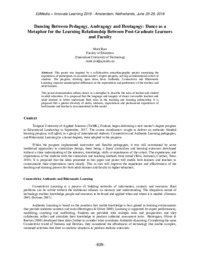Dancing Between Pedagogy, Andragogy and Heutagogy: Dance as a Metaphor for the Learning Relationship Between Post-Graduate Learners and FacultyMark Rasi
Zu finden in: EdMedia 2018, 2018
|
 |
 Diese Seite wurde seit 6 Jahren inhaltlich nicht mehr aktualisiert.
Unter Umständen ist sie nicht mehr aktuell.
Diese Seite wurde seit 6 Jahren inhaltlich nicht mehr aktualisiert.
Unter Umständen ist sie nicht mehr aktuell.
 Zusammenfassungen
Zusammenfassungen
This poster was inspired by a collaborative autoethnographic project examining the experiences of participants in an online master’s degree program, serving an international cohort of students. The program, drawing upon ideas from Authentic, Connectivist and Rhizomatic Learning, exposed unanticipated differences in the expectations and preferences of the teachers and adult learners.
This poster demonstration utilizes dance as a metaphor to describe the roles of teacher and student in adult education. It is proposed that the language and imagery of dance can enable teachers and adult learners to better understand their roles in the teaching and learning relationship. It is proposed that a greater diversity of needs, interests, expectations and professional experiences of both learner and teacher is accommodated in this model.
Von Mark Rasi im Konferenz-Band EdMedia 2018 (2018) im Text Dancing Between Pedagogy, Andragogy and Heutagogy: Dance as a Metaphor for the Learning Relationship Between Post-Graduate Learners and Faculty  Volltext dieses Dokuments
Volltext dieses Dokuments
 |  Dancing Between Pedagogy, Andragogy and Heutagogy: Dance as a Metaphor for the Learning Relationship Between Post-Graduate Learners and Faculty: Volltext als PDF ( Dancing Between Pedagogy, Andragogy and Heutagogy: Dance as a Metaphor for the Learning Relationship Between Post-Graduate Learners and Faculty: Volltext als PDF ( : :  , 211 kByte; , 211 kByte;  : :  2021-03-21) 2021-03-21) |
 Anderswo suchen
Anderswo suchen 
 Beat und dieses Konferenz-Paper
Beat und dieses Konferenz-Paper
Beat hat Dieses Konferenz-Paper während seiner Zeit am Institut für Medien und Schule (IMS) ins Biblionetz aufgenommen. Er hat Dieses Konferenz-Paper einmalig erfasst und bisher nicht mehr bearbeitet. Beat besitzt kein physisches, aber ein digitales Exemplar. Eine digitale Version ist auf dem Internet verfügbar (s.o.). Aufgrund der wenigen Einträge im Biblionetz scheint er es nicht wirklich gelesen zu haben. Es gibt bisher auch nur wenige Objekte im Biblionetz, die dieses Werk zitieren.











 Biblionetz-History
Biblionetz-History